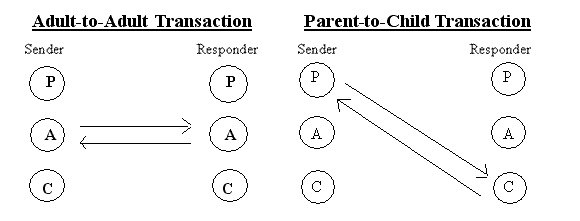| Login | ||

Healthcare Training Institute - Quality Education since 1979
CE for Psychologist, Social Worker, Counselor, & MFT!!

Appendix B
Client acting as Child with “Great Catch” acting
as Parent
The
reproducible client information sheet found on the next three pages provides T.A.
basics
that might be of assistance in your treatment of a client who is working
on relationship issues.
Your client, who feels he or she may have gotten the “Great Catch,” may be maintaining their relationship with their “Great Catch” by co-creating a Parent-Child Communication dynamic. Ask yourself, am I treating a client currently who is involved in a controlling, abusive relationship who may benefit from a review of the following T-A basics?
Transactional Analysis (T.A.), developed by Eric Berne, is a system for understanding human behavior and analyzing the basic types of communications or transactions people have with one another. According to Berne’s system of Transactional Analysis, there are three basic ways people can relate to their environment or interact with others. Berne labeled these the Parent, Adult, and Child...not because people use these styles when they are a specific age, but because those terms are descriptive of the attitude represented by each style. (A simplified description of each of these styles is provided at the end of this chapter.)
Characteristics
of the “Parent” Style of Communication
Your communication is
said to be coming from the Parent style when you are modeling how your parents
or parent substitutes communicated with you when you were a small child. Most
parents relate to their children either as an authority figure or as a nurturing
care-giver. Thus, the Parent style of communication includes words and behaviors
that are critical, domineering, judgmental, demanding, and demeaning, as well
as those that are caring, supportive, and compassionate.
Typical Parent-type messages would be, “You’d better get this d--- report out by ten o’clock sharp! Do you hear me? If you f--- up, you can just start looking for a new job!” or, “I think we should sit over here where the sun won’t be in your eyes. You should have a chef salad for lunch today, it will be good for you and it won’t make you sleepy after you eat.”
Characteristics
of the “Adult” Style of Communication
Your communication is said
to be coming from the Adult style when you are focusing on the current situation
and are gathering and evaluating all the pertinent facts in an objective, unemotional
manner. Thus, the Adult style of communication includes words and behaviors that
are specific, factual, inquisitive, confident, and informative. Typical Adult
messages would be, “This needs to go out in the ten o’clock mail today,
please take care of it,” or, “Where would you prefer to sit, by the
window or by the fireplace? I understand they have a good chef salad here, have
you ever tried it?”
Characteristics
of the “Child” Style of Communication
Your communication is said
to be coming from the Child style when it mimics the feelings and actions you
had as a young child. Thus, the Child style of communication includes words and
behaviors that are creative, impulsive, fun-loving, playful, and spontaneous,
as well as highly emotional, self-centered, rebellious, and aggressive.
Typical Child messages would be, “Gee whiz, I need this stupid report mailed by ten o’clock. Which one of you guys wants to do me a teensy weensy little favor and drop it in the mail lickety-split?” or, “Come on, guys, let's sit next to the window. I get a charge out of ‘people-watching’ while I eat my lunch! What do you say we all take a break from our nutrition kick and have a big, fat, juicy hotdog and hot fudge sundae with all the trimmings!”
So,
Who is the Most Effective Communicator?
Each of the three styles of communicating
and interacting contributes to your relationships with others in many positive
ways. However, each style also has features that can be very anger-provoking,
depending on the time and situation. For instance, you may appreciate the Parent
message, “Watch out!” if you aren’t aware that the car driving
in the lane next to you is starting to swerve into your lane. In this situation
the parent statements such as, “You should learn to drive defensively,”
or, “You're the worst driver I’ve ever seen,” may provoke your
anger, especially if the comment seems critical or judgmental.
The
lack of emotion and spontaneity that make rational, logical, practical Adult statements
ideal in situations that call for problem-solving also make this style of communicating
very frustrating to people who are sad and seeking sympathy, or happy and looking
for a playful companion. Similarly, the carefree, impulsive nature of Child statements
can be very enjoyable and uplifting under the right circumstances. Their irresponsible,
highly emotional nature, however, can be very exasperating to deal with -- especially
when you have serious matters to discuss or important decisions to make.
Any
of the three styles of communication can be appropriate, given the right circumstances.
But in terms of coping with angry feelings and angry people, communicating in
a straightforward Adult-to-Adult manner is the most effective style. When you
communicate from your Adult directly to another person’s Adult, you are least
likely to elicit or intensify that person’s anger.

Parent Adult Child Characteristics Authoritarian,
critical,
nurturing, supportiveUnemotional,
confident,
informative, factualEmotional,
spontaneous,
impulsive, self-centered, rebellious
Functions Instill
values in children.
Make quick decisions.Gather
and study data.
Make logical decisionsHave
fun. Experience life
to its fullest
Tone of Voice Harsh,
demanding, or
sympatheticFirm,
calm, unemotional Exuberant,
playful, or
aggressive Key
Words “Should,”
“ought,”
“don’t worry.”“How,”
“when,”
“according to”“I
want,” “let’s play”
Body Language Pointing
an accusing
fingerAttentive,
alert, good eye contact Demonstrative
or
dejected
Hankins, G., Ph.D. with Hankins, C. (1988). Prescription for Anger. Warner Book, 140-144.

